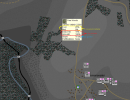Hello!
First, I wanted to say that I’m very impressed by the series and it’s overall goal and design.
However, as it is the case with quite a few other simulation games, this series also suffers from a distinct lack of documentation. Many game aspects are shrouded in mystery and the manual and the forums don’t really help. Since I’m very serious about understanding a game before I fully jump into it, I do a lot of testing and I’m bristling with questions. And I also want to come up with a video tutorial some day. For a start, I took what I believe to be a quite detailed look at how orders are processed and especially command structures (order-delays).
Effect of force-delay
According to my tests, the effect of force-delay is as follows:
Whenever you give an order to a (HQ or normal/subordinate) unit, the unit uses its current force-delay stat (you can look it up in the unit's command tab) to set the starting time of all tasks that are based on this very order, according to the following rule:
Time at which the order was given (NOT processed! given!) + force-delay of the unit that has been given the order = starting time of all tasks based on that order (+/- 1 minute)
For example: At 20:00, you give an order to a battalion HQ which is in command of three subordinate companies. The battalion HQ has a force delay of 30. In this case, all the first tasks (of the HQ unit and each of the 3 companies) that are based on this order will have their starting time set to 20:30.
Similarly, if you give an order to a single company that has no subordinate unit, and the company has a force-delay of 15, and you give the order at 20:00, then the task that the unit assigns to itself based on your order will have its starting time set to 20:15.
Note that for units that have no subordinate units, force-delay always equals unit-delay.
I have no idea what unit-delay is used for. I suppose it’s part of the formula to determine force-delay (see below).
Open questions: What affects force delay?
Now for the more interesting implications: How to take an influence on the delay-stat? Even after some in-depth testing, it remains a big riddle to me how force-delay is calculated. Also, testing is very difficult because the data shown to the player does not seem to get updated automatically. Sometimes, changes in force- and unit delay only become apparent once you’ve given a new order to a (HQ)unit.
For what I believe to be force delay (not unit-delay), the manual mentions a number of factors on page 147-151. I have not yet seen any consistency that I could understand. However, from my observations, I think the manual is correct in stating that the force delay also depends on the respective unit’s superior unit! E.g. a battalion seems to suffer less delay if the battalion commander is command-overloaden (weighted 1/3 according to the manual) than if it’s superior, the regimental commander (2/3) is command-overloaden. Also, if you give a direct order to a unit and thus take it out of the command structure, it's force delay increases - presumably because it now gets it's orders by the onmap-boss which is on a higher hierarchy level with a higher base delay. But to be honest I was not able to see any kind of understandable pattern in the changes of delay that my adjustments to the OOB brought about. I would be very glad if this aspect could be explained by someone more knowledgeable than me.
Open question: Command-overloading the onmap-boss …
From my understanding, players are supposed to suffer increased delays if they give too many direct orders. The game is supposed to simulate this by increasing order-delay for overloading the onmap-boss? However, from my observations, overloading the onmap-boss is 1) hardly even possible, given the very generous command capacity of most onmap-bosses, and 2) has hardly any effect on the delay of his own unit and his subordinate (HQ)units at all? Is this a bug or the way it was intended?
To make my point clear, here is an example: version 5.1.28, Scenario = Highway to the Reich/Operation Garden Final Phase with “painfully realistic” order delay setting, initial delay-free period is already over; Onmap-boss = a divisional HQ, command capacity = 26
Load / unit delay / force delay
3 / 23 / 187
11 / 23 / 187
19 / 23 / 187
33 /25 / 153 (!) (since all units were now under his direct command?)
Giving orders to the onmap-boss
Why does giving an order to the onmap-boss result in an increase in his delay-stats? And then, I wonder why this increase doesn’t seem to affect the force-delay of his subordinate HQs and units? And why can't I "reattach" the onmap-boss?
PS: Some minor bugs/inconsistencies, unrelated to the topic
I just stumbled over the polder-terrain in the Highway to the Reich/Joe's bridge scenario and wondered why motorized units don't seem to be slowed down as much as I expected. According to the ingame-terrain-info, motorized units move with 5% of their speed, according to the manual it's 9%. The latter seems to be more accurate (moving through one grid/1km on perfectly flat polder took a tank unit (17 km/h offroad) about 34 minutes only; at 9% of 17km/h it should have taken me ca. 39 minutes, at 5% it should have taken me ca 70 minutes). So it still seemed quite fast.
Also, in some scenarios, the overlay-map-filters don't seem to work. PS: "Solved". Stupid me. I forgot they only work when the game is paused.
